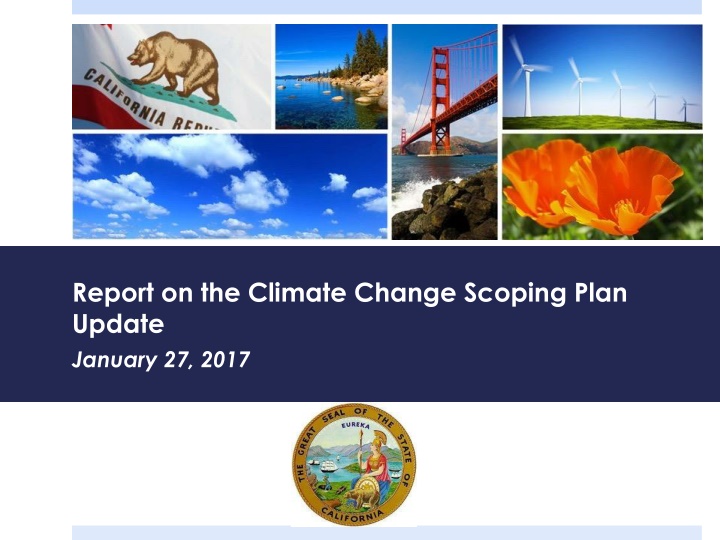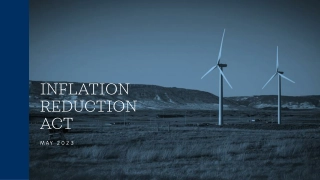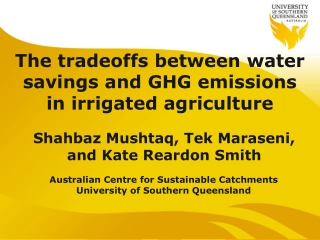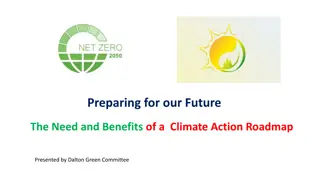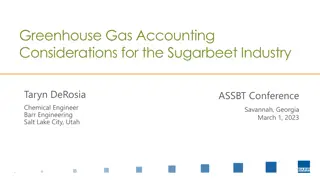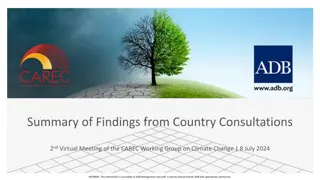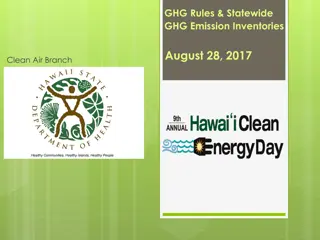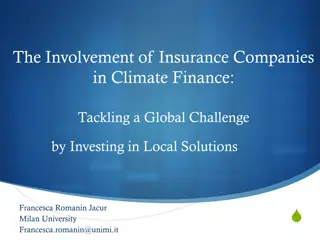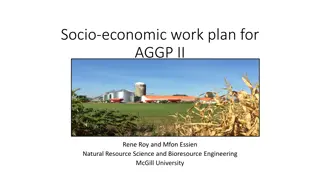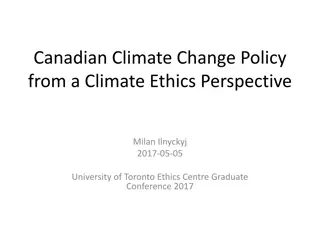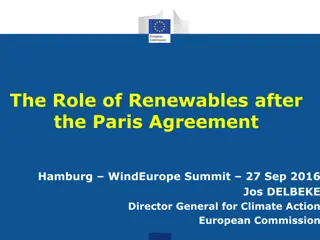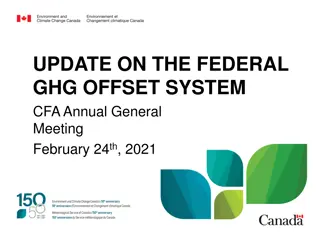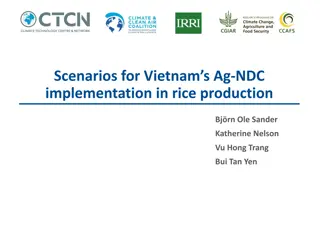Climate Change Scoping Plan Update & GHG Reduction Targets Summary
This report provides an overview of the proposed plan update for the Climate Change Scoping Plan as of January 27, 2017. It outlines the background, process summary, proposed strategies to achieve the 2030 GHG reduction target, and evaluates natural and working lands. It also discusses new directives and legislation related to reducing GHG emissions, along with key objectives for the Scoping Plan.
Download Presentation

Please find below an Image/Link to download the presentation.
The content on the website is provided AS IS for your information and personal use only. It may not be sold, licensed, or shared on other websites without obtaining consent from the author.If you encounter any issues during the download, it is possible that the publisher has removed the file from their server.
You are allowed to download the files provided on this website for personal or commercial use, subject to the condition that they are used lawfully. All files are the property of their respective owners.
The content on the website is provided AS IS for your information and personal use only. It may not be sold, licensed, or shared on other websites without obtaining consent from the author.
E N D
Presentation Transcript
Report on the Climate Change Scoping Plan Update January 27, 2017
Outline Proposed Plan Overview Background Process Summary Environmental Justice Advisory Committee Proposed Strategy to 2030 GHG Target Natural and Working Lands Evaluations Collaboration and Implementation Next Steps 2
Background Most aggressive climate target in North America: 40% reduction in GHGs by 2030 compared to 1990 levels Builds on California s success reducing GHGs Aligns California with the rest of the world in climate change fight Proposed Plan draws on the successes and the lessons learned from the previous plans Proposes continuing major successful programs that have served as a model for other states and jurisdictions around the world Proposed Plan achieves GHG reduction target and continues to make our communities and economy more resilient and equitable at the same time 3
New Directives and Legislation Executive Order B-30-15 Reduce GHG emissions 40% below 1990 levels by 2030 Update Scoping Plan to incorporate 2030 GHG target Senate Bill 32 (SB 32) codifies 2030 GHG target AB 197 Consider the social costs of GHG reductions Prioritize measures resulting in direct emission reductions Follow existing AB 32 requirements including considering cost- effectiveness and minimizing leakage 4
GHG Reduction Targets Emissions to be Reduced by 2020 600 Additional Reductions by 2030 Additional Reductions by 2050 Total GHG (MMTCO2e) 2020 Target 400 2030 Target 200 2050 Goal 0 1990 2020 2030 2050 *Executive Order B-30-15 and SB 32 **Executive Orders S-3-05 and B-16-2012 Note: MMT = Million Metric Tons 5
Objectives for Scoping Plan Achieve 2030 target Provide direct GHG emissions reductions Provide air quality co-benefits Minimize emissions leakage Support climate investment in disadvantaged communities Protect public health Facilitate sub-national and national collaboration Support cost-effective and flexible compliance Support Clean Power Plan and other federal action 6
Progress to Date Reducing GHGs 500 GHG Emissions (MMTCO2e) 475 GHG Emissions 450 425 2020 Limit 431 400 2000 2001 2002 2003 2004 2005 2006 2007 2008 2009 2010 2011 2012 2013 2014 Current modeling shows GHG emissions will be below the 2020 target 7
Building on an Existing Foundation Existing programs are delivering the emissions reductions needed to achieve the 2020 target Program infrastructure exists to support continuation of existing programs High compliance rates demonstrate regulated entities are able to successfully comply with existing programs Gross domestic product (GDP) has continued to grow California is ranked as world s fifth largest economy Per capita and per dollar of GDP GHG emissions have declined 8
Foundational Plans for 2030 SB 375 Sustainable Communities Strategies 2030 Target Scoping Plan 9
2030 Target Scoping Plan Development 15 public workshops since kick-off in Fall 2015 Environmental Justice Advisory Committee 12 Committee meetings and 11 Community meetings throughout the State Coordination across State Agencies Economic Reviewers Economic, environmental, and AB 197 analyses 10
Environmental Justice Advisory Committee Committee held 23 meetings throughout the State 12 Committee meetings and 11 Community meetings Recommendations by sector Partnership with Environmental Justice Communities Equity Coordination Economic Opportunity Long-Term Vision 11
Environmental Justice Advisory Committee Recommendations Recommendations intended to be read and implemented holistically and not independently of each other Long-term community engagement Culture shift in California Improve air quality in EJ communities Maximize benefits for all Californians Consider public health impacts and equity Develop metrics Coordination between government agencies 12
Proposed Scoping Plan Scenario *SB 350 increase renewable energy and energy efficiency *SB 1383 Short-Lived Climate Pollutant Reduction Plan *SB 375 support sustainable community development *Mobile Source Strategy help State achieve its federal and state air quality standards *Low Carbon Fuel Standard Sustainable Freight Action Plan New Refinery Efficiency Measure 20 percent by 2030 Fewer GHG emissions per barrel of a refined product Post-2020 Cap-and-Trade Program Trading and offset usage limit of 8 percent *Existing commitments included in any Scoping Plan Update 13
Natural and Working Lands Goal: Manage California s Natural and Working Lands, including green space in urban areas, to be a resilient net sink of carbon in 2030, 2050 and beyond Continued efforts to model a reference case and management practices to inform performance targets By 2018, develop an Integrated and Working Lands Action Plan to detail how this sector becomes a net carbon sink SB 1383 goal to reduce methane emissions from livestock manure and dairy manure management operations 14
Proposed Plan Meets All Objectives (1 of 2) High probability of meeting 2030 target with hard cap Provides direct GHG emissions reductions from all sectors Provides air quality co-benefits through both command and control regulations and the Cap-and-Trade Program Protects public health through climate leadership, co- benefits, and investment in disadvantaged communities Minimizes emissions leakage through free allocation 15
Proposed Plan Meets All Objectives (2 of 2) Supports climate investment in disadvantaged communities by continuing to provide proceeds for GGRF Facilitates sub-national and national collaboration through linkage of Cap-and-Trade programs Supports cost-effective and flexible compliance by allowing trading Supports Clean Power Plan and other federal action because the Cap- and-Trade program can be used to comply with CPP 16
Alternatives Evaluated No Cap-and-Trade rely on direct measures for all reductions Higher estimated cost Harder to address leakage concerns Less certain to meet 2030 target because regulatory outcomes uncertain No proceeds to fund GGRF Difficult to link with other jurisdictions Carbon Tax replace Cap-and-Trade with a carbon tax Less certain to meet 2030 target because hard to set correct tax rate Harder to address leakage concerns Difficult to link with other jurisdictions Requires additional statutory authority 17
Alternatives Evaluated All Cap and Trade rely on Cap-and-Trade for reductions, no refinery measure and hold LCFS at 10% (all else is already under way or required by statute) Less certainty of emission reductions at refineries Cap-and-Tax require each facility/entity to reduce emissions annually with no trading, emissions would be taxed Higher estimated cost Harder to address leakage concerns, unless cap is set at different levels for trade exposed industry Some facilities may need to cut output to meet targets; jobs/economic impacts Difficult to link with other jurisdictions 18
Proposed Plan Analyses Estimated cumulative GHG reductions by proposed measure Estimated GHG reductions in 2030 for each evaluated measure (AB 197) Estimated criteria pollutant and air toxics reductions in 2030 for each evaluated measure (AB 197) Societal costs for each evaluated measure (AB 197) Cost-effectiveness for each evaluated measure (AB 197) Macroeconomic impacts Environmental impacts 19
Summary of Economic Analysis Under the Proposed Plan, the California economy, employment and personal income will continue to grow The overall impacts of the Proposed Plan are negligible when compared to the overall California economy Annual growth rates in GDP, employment, and personal income are essentially unchanged under the Proposed Plan when compared to the Reference, or no action, scenario The Proposed Plan is estimated to have an economic impact ranging from a cost of $7.6 billion to a savings of $3.8 billion in 2030 depending on future fuel prices 20
Summary of Economic Analysis The Proposed Plan achieves the SB 32 target at the lowest cost of the analyzed scenarios The estimated impact on California GDP is on the order of half of one percent of the estimated $3.4 trillion economy in 2030 The Proposed Plan will result in a 3-month delay in reaching the GDP projected under the Reference, or no action, scenario The estimated annual cost to a California household ranges from $30 to $214 dollars in 2030 depending on the Cap-and- Trade allowance price 21
Environmental Analysis (EA) Draft EA provides an analysis of both the beneficial and adverse impacts and feasible mitigation measures for the reasonably foreseeable compliance responses associated with the recommended measures 22
Public Health Achieving Health Equity through Climate Action Potential Health Impacts of Climate Change Mitigation Measures Communications Supporting Climate Change Behaviors and Policies Community Engagement Leads to Robust, Lasting and Effective Climate Policies 23
Intergovernmental Collaboration Federal California polices have been foundation for national polices U.S. EPA Clean Power Plan support State efforts State Polices for State climate goals Action, advocacy, and collaboration 24
Local Action Opportunities to support State climate goals Recommended community-wide goal of 6 MTCO2e per capita by 2030 and 2 MTCO2e per capita by 2050 implemented through Climate Action Plan Beyond plan level actions, local governments can support State goals through individual projects via CEQA Projects with emissions in excess of threshold, incorporate all feasible mitigation 25
Next Steps CEQA comment period: January 20 March 6 Workshops in February and March EJAC and Community Meetings February Board Hearing March 2017: Release Final Proposed Scoping Plan April 2017: Final Board consideration 26
